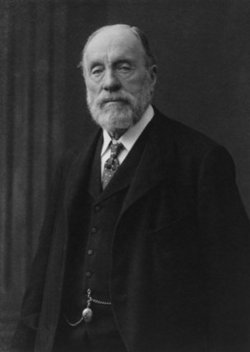John Wolfe Barry (John Worlfe Barry)

Wolfe-Barry was educated at Glenalmond and King’s College London, where he was a pupil of civil engineer Sir John Hawkshaw, as was Henry Marc Brunel, son of the great Isambard Kingdom Brunel. Barry and Hawkshaw worked on railway bridge crossings across the Thames, among other projects (Brunel pursued his own business from 1871, but in 1878 went into partnership with Barry). Barry began his own practice in 1867, and carried out more work for the railways.
However, it was Tower Bridge that made Wolfe-Barry’s name. In 1878, architect Horace Jones first proposed a bascule bridge. An Act of Parliament allowing the Corporation of the City of London to build it was passed in 1885. Jones was appointed architect, and developed an initial scheme for which he was knighted in 1886. Wolfe-Barry, already well-established with experience of bridges across the Thames, was introduced as the engineer for the project and redesigned the mechanisms resulting in a modified plan. Within a month of construction starting Sir Horace Jones died, leaving Wolfe-Barry to oversee the works and specialists. The bridge was completed in 1894.
A recognised industry leader (he was elected President of the Institution of Civil Engineers in 1896, knighted in 1897, and served on several Royal Commissions), Wolfe-Barry played a prominent role in the development of industry standardisation, urging the ICE’s Council to form a committee to focus on standards for iron and steel sections. Two members each from the ICE, the Institution of Mechanical Engineers, the Institution of Naval Architects and the Iron and Steel Institute first met on 26 April 1901. With the Institution of Electrical Engineers who joining the following year, these bodies were the founder institutions of what is today the British Standards Institution or BSI. He was elected a Fellow of the Royal Society in 1895 and knighted KCB in 1897. He was elected President of the Institution of Civil Engineers in 1898, in which year he assumed his middle name of Wolfe as an additional surname. He was also a member of the Smeatonian Society of Civil Engineers.
He was chairman of Cable and Wireless from 1900 to 1917. In 1902 he joined the consulting firm of Robert White & Partners, which was renamed Wolfe-Barry, Robert White & Partners (later, in 1946, renamed Sir Bruce White, Wolfe Barry and Partners and now part of London-based consultancy Hyder Consultants). Wolfe-Barry died in January 1918 and was buried in Brookwood Cemetery near Woking in Surrey. He had married Rosalind Grace, the daughter of Rev Evan Edward Rowsell of Hambledon, Surrey. They had four sons and three daughters. In 1922 a memorial window designed by Sir John Ninian Comper was dedicated to his memory in the nave of Westminster Abbey.
Born
- December, 07, 1836
- England, United Kingdom
Died
- January, 22, 1918
Cemetery
- Brookwood Cemetery
- Surrey, England



